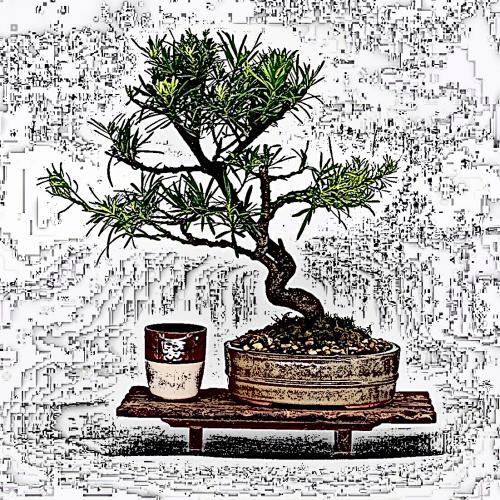Bonsai class 7

[This is a continuing series of spontaneous and unrehearsed "classes" on the subject of bonsai. Many new readers were coming on board asking about how to get started. I believe you should just start making bonsai. So, I will try to lead you through creating your first. Besides this gentle counsel, be sure to read the FAQ (which appears periodically) and search out some good books or people to introduce you to the subject. I will post sporadically with a subject containing the word "Class". I am going slow, so be prepared to be frustrated. If you have questions or comments about building your own first bonsai, post them "Re:" this thread. Write me (rkn@guest.apple.com) for back issues. -Hud]
===
Where did I leave you? Ah, I must have talked you into starting to shape your bonsai by now. I received many statements to that effect via mail, most of them reporting good news. Some accelerated learners have taken up bonsai books or found local expertise to guide them right through to a finished product, if a bonsai can ever be described as finished. Great! Don't let my lethargic pace slow you down. In any case, even if it is only dreaming, whatever you have accomplished, I applaud you!
OK, I hope you have obtained some raw material and started cutting away all the foliage and branches that weren't part of a bonsai.
Often the usual mistake made by a beginner at this point, save the usual aesthetic errors that one learns to avoid with experience, is a tendency to not remove enough material. While that problem can be fixed later by further pruning, so, too, can the problem of removing too much material, by having the tree grow new branches. So, do not lack courage; remove what is necessary.
===
Since you have removed a good deal of your tree's foliage, some say you now have some starving roots on your hands (and, some say the tree automatically adjusts by just slowing down root growing activity). In any case, since you have shaped the new tree, you probably still have more roots than it needs, and you want to move it into a better looking pot.
(You have to do something about your tree's roots every two, or several, years, depending on species. Generally it is more often for deciduous trees and less often for conifers. So, get used to the idea. What? You thought you were going to shove your plant in a pot and just water it once in a while? Heh. It is more dependent on you than that! While a young tree grows larger, a slightly larger pot is required every few years. Even old trees that grow slowly, exhaust the soil nutrients and crowd their pots with roots and need periodic transplanting or repotting with fresh soil and fewer roots.)
Important, though, is transplanting at the right time. In general, this is when the roots are about to enter an active growing phase (in the spring before new growth starts appearing, and, for some trees, in the late summer after a slow-down due to heat), so that they may recover from the damage. It is better to put off work on the roots until a good time. Here's another case for getting a decent reference book on bonsai; many give you those months on a species-by-species basis.
Let me describe what you have to do to get your tree into a bonsai pot. Actually, what might be better for your tree, especially your first tree, which you have come to dearly cherish by now, is to get it into a so-called training pot, a place for it live for a while before you take the big step of placing it in a shallow bonsai pot. I will cover that after this brief explanation of the ideal.
===
Contrary to the look of age that we seek in the visible portion of the tree, underground, where nobody but us ever looks, we are after youth. Old roots don't do anything except transport water and nutrients from and to the tips of the roots. All the action is in the youthful, constantly growing, root tips, and you want plenty of them to sustain your tree.
How do we ensure that? With our old ally pruning. By pruning the roots we encourage ever more and better roots.
The basic technique is to remove about a third of the roots. Since they are often in a tangled state, you need to do a little sorting out so you can cut off the lower third of the roots. In so doing, you can disturb another third of the roots, but try to leave one-third of the roots, near the trunk, in an undisturbed ball of soil. Again, in the aspect of root-pruning there is some variation by species, but one third is a good rule of thumb. A large tub of water can be useful for exposing the roots, helping to wash away loose soil, and, by buoyancy, providing some support for the delicate roots.
Nursery-bought plants can often have an abundance of roots in the container, and in that case you can take off a wee bit more. Also, roots in the container may be coiled fairly tightly around the trunk and main roots; that should be corrected so that the roots radiate away from the trunk.
If possible, cut roots on the diagonal for better healing, and on large roots make the cut point downward. Don't let the roots dry out during the process; mist them with water if necessary.
You should have a pot ready to receive the tree and some soil prepared.
We'll talk about pot selection in the future.
Soil recipes are abundant in the literature, and at times contradictory. I suspect that those who offer advice, even when based on careful experimentation, are advising a soil that best suits all the other ways they treat their trees; there are just so many variables. I'll offer some up in the future.
For now, a good rule of thumb is to match the fresh soil to whatever you find the tree currently growing in. Look for particle size, moisture holding ability, organic content,... The list is endless, but that's a good start. You can do much worse than use plain off-the- shelf general-purpose potting soil. I've done that when too lazy to mix up a batch of soil, and the trees suffered no appreciable harm. But, you can do better, and in the tight confines of a shallow bonsai pot, with a precious but finicky tree, and a lack of experience, you probably want to give the tree the best soil you possibly can; in that case call out the experts: read a book or find someone to advise you.
The pot should provide good drainage; you don't want the tree sitting in mud. Cover the drain hole with a little piece of screening to hold in the soil. Many recommend having layers of soil, from coarse at the bottom, to fine at the surface. Others recommend a uniform mixture.
Often you will have to anchor the tree to the pot so it will stand upright while its new roots are growing into the soil. Some twine of a natural fiber, something that can rot away over time, is good for that. You can make an invisible loop around the root-ball and thread the twine out the drain hole to tie to a stick of wood on the bottom of the pot. Or, you can tie the trunk to the rim of the pot. Anything that gets it stabilized for a while.
Position the trunk at an aesthetically pleasing point within the pot, broadly: for rectangular or oval pots one-third from the end, and for symmetrically shaped pots in the center, in both cases just slightly to the rear of the center line. Don't forget that your tree has a front side. The visible surface roots, if you are lucky enough to have some, define the depth of the soil. Be sure to remove enough soil from the surface to expose the full length of the trunk; you may have to remove a few fine roots. The soil is often formed into a mound that slopes down to the rim of the pot. You do not have to create a basin to hold water; in fact, watering is often better done from below, by immersing the whole pot in water for a bit, until air bubbles stop coming out of the soil.
Add soil, whatever magical mix, in whatever magical layers, so that no air pockets are left. Dry soil is easier to pack. A stick is useful for working soil in around the roots. Pack the soil well, but not so firmly as to constrict the movement of water. Smooth the top of the soil with a small, flat tool.
A finishing nicety is a thin layer of green moss on the surface; it looks good and does can make maintenance a little easier. Keep your eyes open for ready sources. It probably grows all around you.
Water your tree. Quick! It's been through a tough time. Keep it in a benign semi-shade for a few weeks while it recovers, and watch its need for water closely (now and for evermore).
===
But, let's take it a little easier on our little friend by moving it to a training pot for a nice long rest. A training pot is deeper than a classic bonsai pot, and can be made of plastic or clay. It should be more shallow than the pot your plant came in--halfway between where it is and where it will finally be is ideal. We are talking probably 4 or 5 or 6 inches, here. It's not critical. Deeper is a little easier on the tree now; shallower is closer to where it will finally wind up. I find "azalea pots"--clay pots for shallow soil-preferring azaleas--nice to use and easy to find. We don't have to be quite so fussy about soil recipes and exact root-pruning when the tree's destination is a training pot. You still can remove about a third of the roots, by simply cutting off the lower third of the soil and roots, if only to get the root-ball to fit in the new pot. You may not even have to remove any old soil or add new, but if you do, again, try to match the soil to whatever the tree is currently growing in.
Aesthetic placement of the tree is less important, for the training pot itself is no thing of beauty. But, you can place the trunk a little off-center, in the same direction it will be in its final bonsai pot. Prune the roots accordingly to make room. In the training pot you can leave a little basin to catch water to make surface watering possible.
After repotting, again, water the tree thoroughly, and keep it in semi- shade for a few weeks while it grows fresh new roots. It's a good time to apply a root stimulator containing napthaleneacetamide or variant.
You can let your tree reside in this training pot for the remainder of the year, until the time--hopefully the ideal time for transplanting-- comes to move your tree to a shallow pot.
Or, you can be like me and keep it there indefinitely. OK, my excuse is that I am too busy to check water needs a couple of times a day (for the warm, dry climate), and sometimes I even forget to water. I get away with it because most of my trees are in deeper pots. Some day, I'll rig up protection from the hot mid-day sun (or move to a house with something other than southern exposure) and get them into nicer pots! Really.
===
Whew, that was longer than I planned. And, I gave a light treatment to so much!
If you have pruned your tree to shape it, and pruned the roots some to encourage new growth, and gotten it into a shallower pot, then you have accomplished much. You might have a pretty decent-looking bonsai by now. But, its shape may still be lacking. I'll try to figure out something to say about wiring next time.
At least your tree should be in pretty good health, trimmed up, growing new roots and foliage, resting in semi-shade, well watered, and soon ready to to take a few final steps to becoming a full-fledged bonsai.
Don't despair if you are not pleased with the results to date. One of you wrote about being rather unhappy with the results of pruning, making me a bit blue, but then surprisingly continued on to express pleasure over the results of wiring the tree. So, there is hope!
You can do it.
Still with me? Having fun?


















